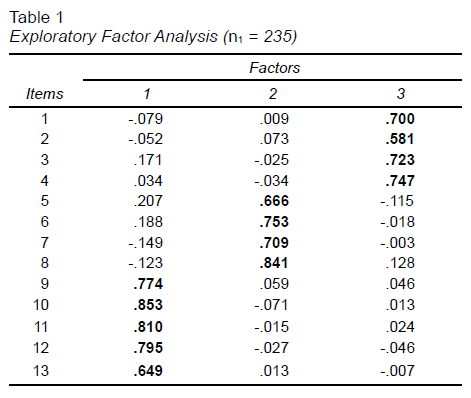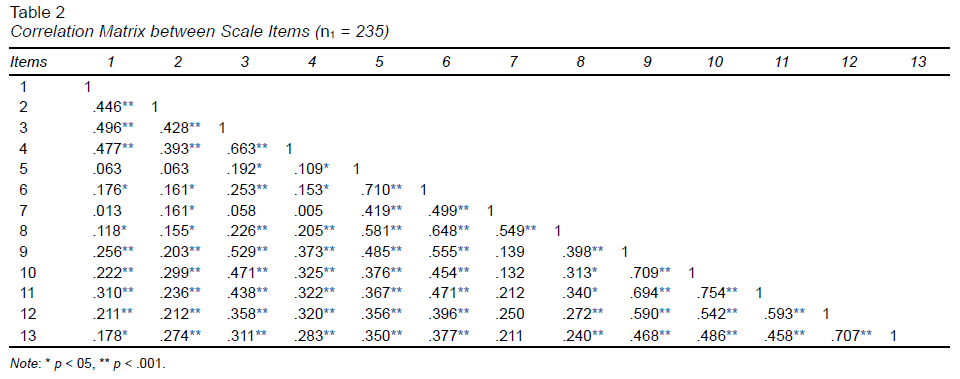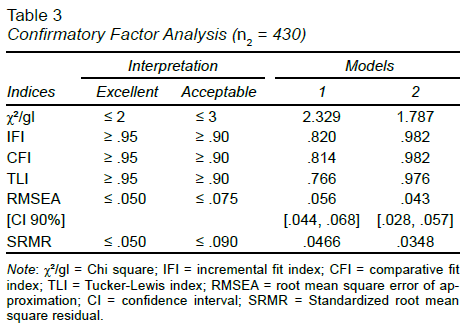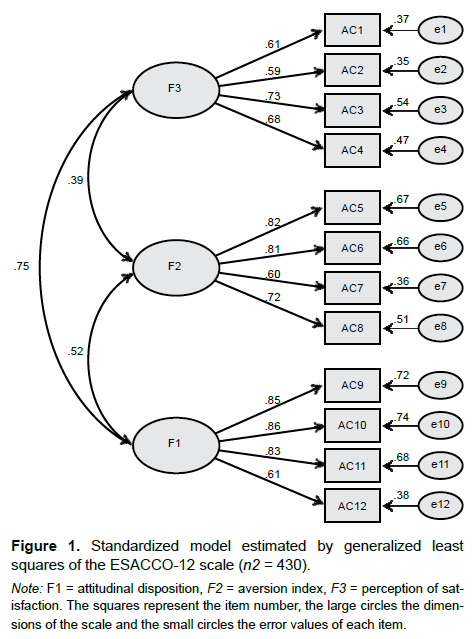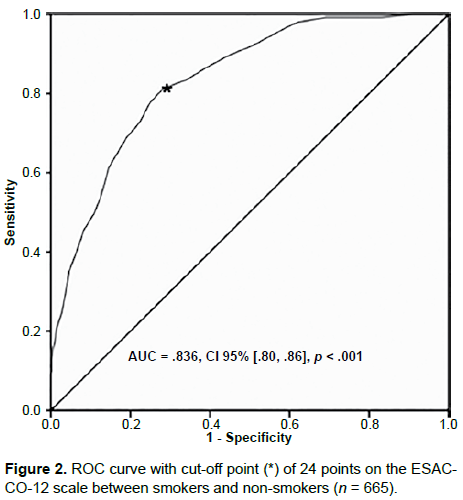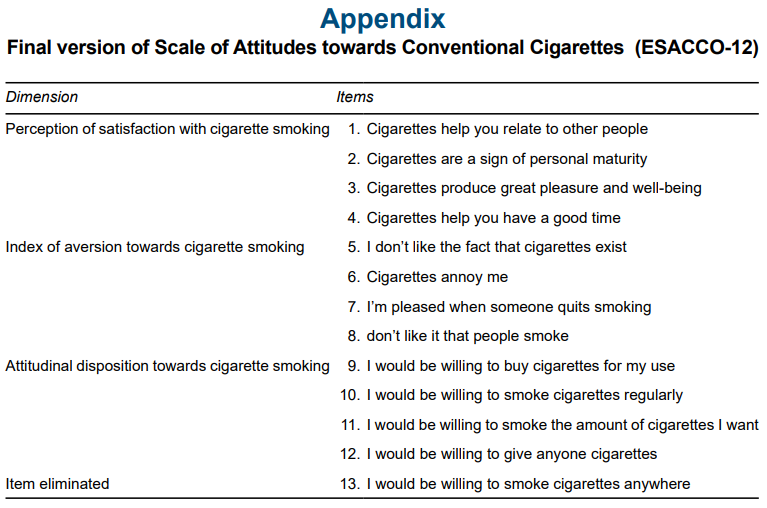INTRODUCTION
Tobacco use among young people continues to be a public health problem. In Mexico, the highest prevalence of tobacco use (27.1%) has been found in young people ages twenty to twenty-nine (Zavala- Arciniega et al., 2020). In keeping with the above, studies of young university students have found high prevalences of tobacco use ranging from 19.5% to 31.5% in Mexico (González Angulo et al., 2019; Sánchez-Hoil et al., 2017; Vallejo et al., 2019) and other countries (Bauer-Kemeny et al., 2020; Correa-López et al., 2020; Hassan et al., 2019; Loukas et al., 2019).
Given this situation, further study is required of the factors encouraging tobacco use to understand and intervene to reduce these behaviors, given that youth is a crucial period for the adoption of risky behaviors such as tobacco use (Gaete, 2015). According to the Theory of Planned Behavior, the attitude of an individual towards a certain behavior predicts their aim of engaging in the latter (Ajzen, 1985). Some studies have found that favorable attitudes towards tobacco use predict the onset of or current cigarette smoking among university students (Al Omari et al., 2021; Pardavila-Belio et al., 2019; Sidani et al., 2014). However, to date, no psychometric validation studies of questionnaires evaluating attitudes regarding tobacco or conventional cigarette use in the Mexican population have been found.
Given the above, identifying attitudes can help understand why young people use conventional cigarettes. A critical step in accurately assessing conventional cigarette smoking among youth is the development of a measure to examine attitudes toward it. The aims of this study were therefore twofold. The first was to culturally adapt the scale of attitudes towards conventional cigarettes, and the second was to evaluate the construct validity, internal consistency, and discriminant validity of the scale among Mexican university students.
METHOD
Study design
A cross-sectional design was used.
Subjects
A total sample of 665 undergraduate students (two independent samples: n1 = 235, n2 = 430) was obtained from the area of social and health sciences at a public university in the state of Nuevo León, Mexico, in April (n1 = political science faculty) and September (n2 = psychology, communication and visual arts faculty) of 2022, with a refusal rate of 1%. Convenience sampling was applied, and the sample size was considered adequate for factor analyses (Brown, 2015).
Measurements
A paper survey was used, and a registration form was created to obtain demographic information (age, sex, and semester) from the participants.
A four-item questionnaire on conventional cigarette use was administered with dichotomous response options (Yes/No): Have you ever smoked a conventional cigarette? Have you smoked a conventional cigarette in the past twelve months? Have you smoked a conventional cigarette in the past thirty days? and have you smoked a conventional cigarette in the past seven days? Participants whose answers were “Yes” in the past year, thirty days or seven days were considered smokers. Participants using other possible answer options were considered non-smokers.
The Attitudes towards Smoking Scale validated by García del Castillo et al. (2012b) in Spanish adolescents was used. This scale provides information on attitudes towards conventional cigarettes. It is a Likert scale with five response options (Strongly agree = 5, Agree = 4, Indifferent = 3, Disagree = 2 and Strongly disagree = 1), comprising thirteen items (items five to eight are scored inversely), designed for the adolescent and adult population.
The scale comprises three dimensions. The first evaluates attitudinal disposition towards cigarette smoking (items 9-13), the second evaluates the index of aversion to cigarette smoking (items 5-8), while the third evaluates the perception of satisfaction with cigarette smoking (items 1-4). The total score ranges between 5 and 65, with higher values indicating a more favorable attitude towards smoking. The scale has shown acceptable reliability indices in the Spanish population with a test-retest coefficient of .50 (García del Castillo et al., 2012b) and a Cronbach’s alpha greater than .76 in each dimension in the Portuguese population (García del Castillo et al., 2012a).
Procedure
First, the scale was reviewed by three expert researchers in the area of drugs. The reviewers agreed to change the word “tobacco” to “cigarette smoking” because the latter is used in national drug use surveys in Mexico when specific reference is made to conventional cigarettes, also called combustion cigarettes, rather than other tobacco products such as e-cigarettes or heated tobacco (Instituto Nacional de Psiquiatría Ramón de la Fuente Muñiz et al., 2017). As a result of these changes in the wording of the questions, the scale was considered to be equivalent to the original version in regard to the construct being evaluated. No significant differences were therefore expected to occur regarding the construct it is designed to measure. The instrument was then piloted with university students with similar characteristics to the participants in this study. At the end of the test, students were interviewed individually to determine whether they had understood the questions or experienced any difficulty answering them. All of them reported that they had understood the questions and wording of the instrument.
The new version of the scale was subsequently administered to two independent samples. Students enrolled in the faculties, who were present during the data collection, were included. Participants were intentionally selected as a group in the faculty classrooms. Afterwards, they were verbally invited to participate, and those who agreed to participate granted their consent. Average survey completion time was ten minutes.
Statistical analysis
The Kaiser-Meyer-Olkin (KMO) test and Bartlett’s sphericity were used to evaluate the adequacy of the data for factor analysis. Exploratory factor analysis was performed with the principal axis factorization extraction method with pro max rotation (López-Aguado & Gutiérrez-Provecho, 2019) because the data were not normally distributed (p < .001). The model was then contrasted with confirmatory factor analysis; the criteria for evaluating the model are specified in Table 1 (Hu & Bentler, 1995). Internal consistency was estimated using Cronbach’s alpha and McDonald’s omega coefficient for Likert-type scales; values of .70 or higher were adopted as criteria to represent acceptable internal consistency (Hayes & Coutts, 2020; Terwee et al., 2007). Discriminant validity was evaluated through the ROC curve, and the Youden index was used to identify the sensitivity and specificity of the scale (Youden, 1950). Statistical analyses were performed with SPSS AMOS 23.
Ethical considerations
The procedures used in this study adhered to the principles of the Declaration of Helsinki (World Medical Association, 2017) and the General Health Act on Health Research (Diario Oficial de la Federación de México, 2021). Participants signed an informed consent form and the confidentiality, anonymity and security of their information was protected at all times. The research protocol was approved by the Research and Ethics Committee of the Nursing Faculty of the Autonomous University of Nuevo León with registration number FAEN-1858.
RESULTS
Six hundred and sixty-five students ages 16-40, with an average of 19.62 years (SD = 2.17) participated, with 56.4% of women and 43.6% of men. As for the semester in which they were enrolled, 15.3 were in the first, 12.8% in the second, 9.0% in the third, 28.6% in the fourth, 7.1% in the fifth, 7.8% in the sixth, 9.2% in the seventh, and 10.2% in the eighth semester.
The Kaiser-Meyer-Olkin (KMO) analysis showed sampling adequacy of the variables (.85) and Bartlett’s test of sphericity was significant (X2 = 2774.75; df = 91, p < .001) for the data (n1 = 235) in the new version of the scale. As can be seen in Table 2, the correlation patterns between the items were positive and statistically significant.
Exploratory factor analysis identified three components explaining 65.26% of the total variance of the thirteen items. Three factors were confirmed after rotating the component matrix: factor one, “Attitudinal disposition,” comprising five items; factor two, “Aversion Index,” comprising four items; and factor three, “Perception of satisfaction,” with four items. All the items showed loadings greater than .50 (Table 1). The assignment of the names of the factors followed the dimensions proposed by García del Castillo et al. (2012b), while the grouping of the items coincided with that of the Spanish and Portuguese version.
The three-factor model produced was contrasted in the confirmatory factor analysis. The results in model one were considered inadequate. The IFI and CFI values were less than .90, suggesting poor model fit (Table 3). A re-specification of the factor model was therefore conducted. The modification indices indicated that the residuals of items 12 and 13 correlated (p = .39). After a statistical and theoretical analysis, item 13 “I would be willing to smoke cigarettes anywhere” was eliminated. Model two showed excellent measures of fit in all indices (χ2/df = 1.78, IFI = .98, CFI = .98, TLI = .976, RMSEA = .043; 90% CI = [.028, .057], SRMR = .034; Table 3).
Figure 1 shows the standardized regression coefficients between the factors, ranging from .39 to .72, as well as the correlations of the factors and items, ranging from .59 to .86.
The Cronbach’s alpha and McDonald’s omega coefficient for the 12-item ESACCO-12 scale (appendix) were .875 respectively, indicating excellent reliability. The discriminant capacity of the scale between smokers and non-smokers was 83.6% (AUC = .836; 95% CI = [.80, .86], p < .001), while the cut-off point of the scale was 24 points, with a sensitivity of 81% and specificity of 71% (Figure 2).
DISCUSSION AND CONCLUSION
The cultural adaptation concluded with minimal modifications to the items in the original scale, which were validated through the results of the pilot test, showing that the university students had understood the wording of the questionnaire. This shows that the adapted scale is equivalent to the original version and guarantees the measurement of the same construct in university students.
Regarding the construct validity of the scale, this study confirmed a three-dimensional structure (García del Castillo et al., 2012a; García del Castillo et al., 2012b), given that the confirmatory factor analysis showed an excellent model fit with twelve of the thirteen original items. The “Perception of satisfaction with conventional cigarette use” showed almost the same structure as four out of the five original items. Item 13, which was originally in this dimension, was not included because it showed a residual correlation with Item 12. This was possibly due to a perceived redundancy of the content of the items (Byrne, 2009) or the proximity between the latter (Domínguez-Lara & Merino-Soto, 2017). It is therefore suggested that the items be distributed among the dimensions when the surveys are administered. This study is the first to use confirmatory factor analysis to evaluate the construct validity of the scale, which allowed problems between the items to be identified. The changes made it possible to obtain excellent factor indices, suggesting that this measurement scale is more robust than the other versions (García del Castillo et al., 2012a; García del Castillo et al., 2012b).
In keeping with the above, the internal consistency coefficients of the scale were higher than those of the Spanish (García del Castillo et al., 2012b) and the Portuguese versions (García del Castillo et al., 2012a), indicating a greater reliability of the scale in university students.
Likewise, this is the first study to evaluate the discriminant validity of the scale, which obtained optimal discriminant power to identify subjects who smoke conventional cigarettes based on the general scores (twenty-four points) of the scale of attitudes towards conventional cigarettes. This result supports the assumption of the Theory of Reasoned Action, which states that a behavior is influenced by the favorable or unfavorable attitudes a person has about that behavior (Ajzen, 1985). In this case, students who scored higher on the scale of attitudes towards conventional cigarettes smoked conventional cigarettes. The discriminant sensitivity of the scale can therefore be used to detect people at risk of conventional cigarette smoking by evaluating their attitudes towards conventional cigarettes in prevention programs at educational centers and in intervention studies on conventional cigarette use.
Strengths of the current study include its consistent results, adequate sample size for statistical analyses, and the analysis of the sensitivity of the scale. However, the study findings should be considered in light of certain limitations. Although the data were self-reported, and therefore limited by the ability and willingness of the study participants to provide accurate responses, these factors were offset by the anonymity of the survey and the lack of evidence that any of them had provided random responses. Given that the sample was limited to university students in the area of social and health sciences, and that this scale has not been used in clinical populations for tobacco use disorder, further research could explore the strengths and limitations of the scale in adolescents or adults, university students from other areas, workers, or participants in clinical rehabilitation settings.
Since it was not possible to evaluate biomarkers (such as nicotine) as a direct indicator for analyzing the sensitivity of the scale, it would be worth analyzing whether nicotine levels in participants are associated with the levels of the scale. At the same time, given that e-cigarettes have been considered a public health problem with similar characteristics to conventional cigarettes, this scale could be adapted to evaluate attitudes towards e-cigarettes, as in other studies that have adapted instruments for the study of e-cigarettes based on instruments evaluating conventional cigarette use (Foulds et al., 2015; Morean et al., 2019).
In conclusion, the Mexican version of the Scale of Attitudes toward Conventional Cigarettes (ESACCO-12) possesses high construct validity and reliability. It is considered to be a simple, valid tool for evaluating attitudes toward conventional cigarette use among Mexican university students.
